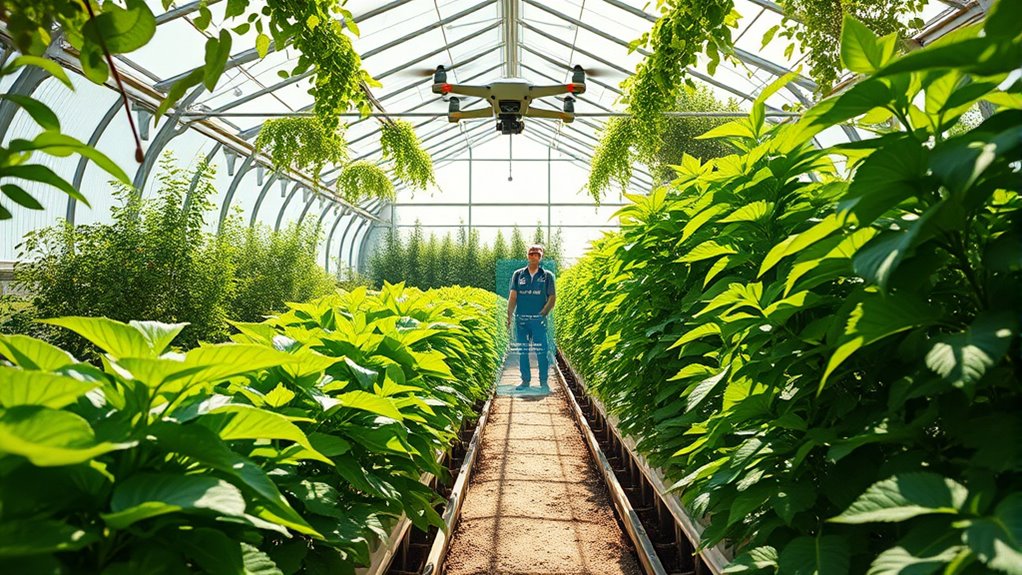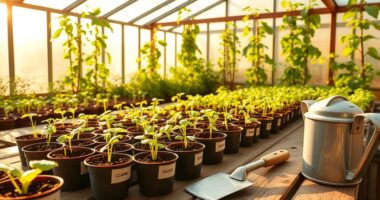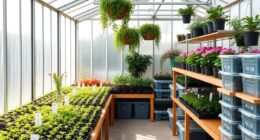In 2025, I foresee AI solutions revolutionizing greenhouse management by automating climate control, optimizing resources, and improving crop yields. These innovations will make it easier for you to manage energy efficiency and reduce costs. By integrating real-time data, you'll make informed decisions effortlessly. Plus, user-friendly interfaces will enhance accessibility for every level of gardener. Stick around, and I'll share detailed insights on how these technologies can elevate your greenhouse operations even further.
Key Takeaways
- AI-driven climate control systems optimize temperature and humidity, reducing energy costs by up to 30% while improving crop yields.
- Integrated data analytics tools enable real-time monitoring and predictive modeling, enhancing decision-making for resource management and crop performance.
- User-friendly interfaces with customizable dashboards facilitate intuitive navigation and streamline operations for greenhouse managers of all skill levels.
- Automation of irrigation and fertilization tasks minimizes labor costs and ensures consistent crop care, increasing operational efficiency.
- Scalable AI solutions adapt to growing greenhouse demands, seamlessly integrating with existing systems and enhancing overall productivity.
Greenhouse Operation and Management

When it comes to greenhouse operation and management, I believe that "AI Solutions for Greenhouse Management" is the best choice for both aspiring and seasoned growers. This book is an extensive resource that dives deep into commercial protocols and system layouts. It addresses everything from lighting to fertilizers, ensuring that I'm equipped with the right knowledge to enhance my skills and crop quality. I've found it invaluable for both personal and commercial ventures. While some might find the writing a bit dry, the clear information makes it a reliable reference, especially for those enrolled in horticulture programs.
Best For: Aspiring and seasoned growers looking for an extensive resource on greenhouse operation and management.
Pros:
- Comprehensive coverage of topics related to greenhouse operations, including lighting, fertilizers, and system layouts.
- Clear and concise information, making it a reliable reference for students and professionals in horticulture.
- Well-regarded in educational settings, having been utilized in courses at institutions like NW Tarrant County Community College.
Cons:
- Some users have reported issues with the condition of the book upon receipt, leading to quality concerns.
- The writing style may be perceived as dry and repetitive, which could detract from the reading experience.
- Limited engagement for those seeking a more dynamic or interactive learning approach.
GREENHOUSE MANAGEMENT

For anyone looking to elevate their greenhouse operations, "AI Solutions for Greenhouse Management" stands out as an invaluable resource. This book covers essential knowledge that's essential for success in horticulture. I found it not just informative but engaging and easy to understand. Each chapter offers fresh insights, keeping my excitement alive as I learned. It's more than just a guide; it's a roadmap for career development in the industry. The assessments on greenhouse management are fundamental for anyone involved, and I highly recommend this book for anyone aiming to thrive in greenhouse operations. It truly encompasses everything needed for success.
Best For: This book is best for horticulture professionals and enthusiasts seeking to enhance their greenhouse management skills and knowledge.
Pros:
- Comprehensive coverage of greenhouse management topics, making it a reliable resource.
- Engaging and easy-to-understand format that keeps readers interested and excited about learning.
- Valuable assessments and guidelines for career development in the horticulture industry.
Cons:
- Some readers may find certain sections too technical if they are beginners in horticulture.
- The book may not cover specific niche topics in greenhouse management that some advanced practitioners seek.
- Availability may be limited, making it difficult to access for some potential readers.
Greenhouse Types, Designs, and Energy Management
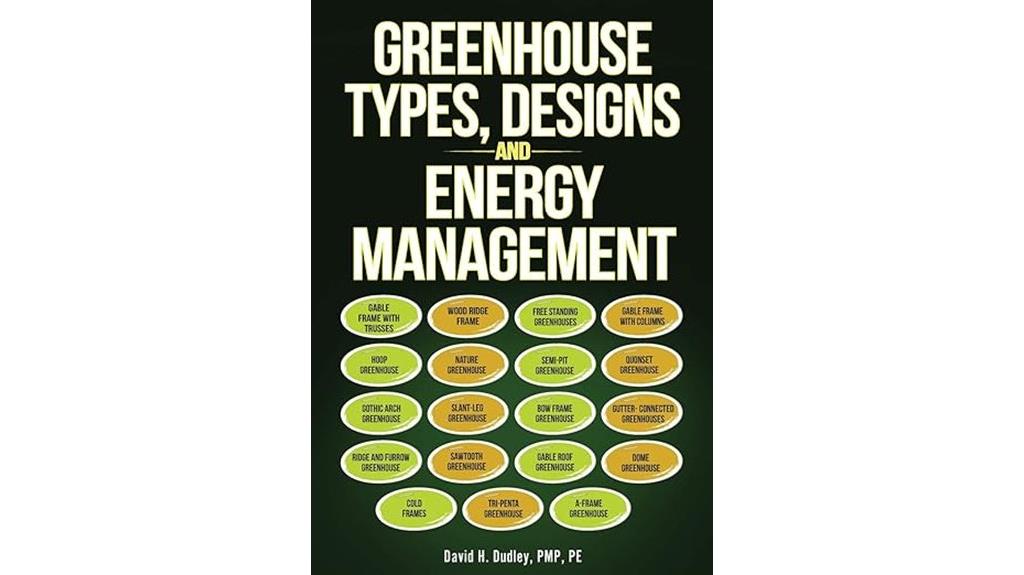
If you're a greenhouse enthusiast looking to deepen your understanding of various greenhouse types and designs, "AI Solutions for Greenhouse Management" is your go-to resource. I bought three greenhouse books, but this one stood out as the best. It covers everything about greenhouse types, designs, and energy management. You'll appreciate the helpful tables, diagrams, and pictures that enhance the content. The readability makes it easy to grasp complex concepts. While some reviewers found it informative, others suggested checking out additional options for more detailed insights. Overall, this book is a valuable investment for anyone serious about greenhouse management.
Best For: Greenhouse enthusiasts and professionals seeking comprehensive knowledge on greenhouse types, designs, and energy management.
Pros:
- Covers a wide range of topics related to greenhouse management.
- Includes visual aids like tables, diagrams, and pictures for better understanding.
- Easy to read, making complex concepts accessible.
Cons:
- Some readers found the information less detailed compared to other resources.
- Mixed reviews suggest exploring additional options for more insights.
- May not be suitable for advanced users looking for in-depth technical details.
MetaShift: Why Great Leaders Get Stuck in the AI Era
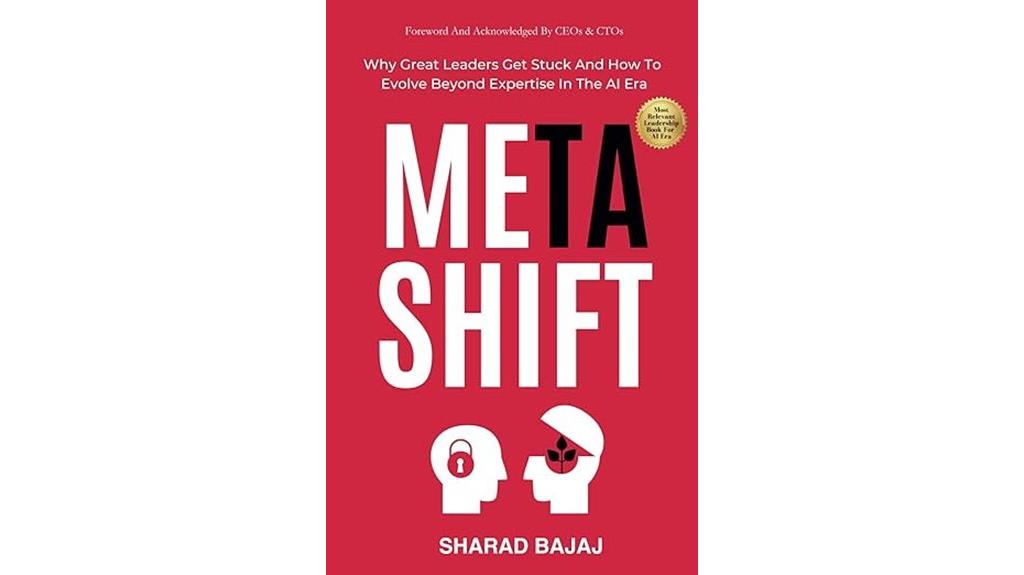
Great leaders often find themselves at a crossroads in the AI era, struggling to adapt their traditional leadership styles to a rapidly changing landscape. In "MetaShift," Sharad Bajaj highlights how reliance on outdated expertise can lead to stagnation. I've seen firsthand that past successes don't guarantee future effectiveness. Bajaj's actionable insights encourage self-reflection and adaptability, essential for traversing this new terrain. By embracing vulnerability and fostering team empowerment, leaders can break free from old myths. This book is an essential resource for anyone looking to stay relevant and impactful in an AI-driven world. Let's evolve together and redefine our leadership journeys.
Best For: "MetaShift" is best for leaders and managers seeking to adapt their leadership styles to remain relevant in an AI-driven landscape.
Pros:
- Practical insights: The book offers actionable strategies and real-world examples that are easy to implement.
- Encourages self-reflection: It promotes personal growth and accountability, helping leaders to reassess their approaches.
- Empowerment focus: The content emphasizes the importance of team empowerment, fostering a collaborative work environment.
Cons:
- Challenging concepts: Some readers may find the shift in thinking and leadership style difficult to grasp initially.
- Limited technical depth: The book may not dive deeply into specific AI technologies, which some leaders might seek.
- Target audience specificity: While it's beneficial for engineering leaders, other sectors may find some concepts less applicable.
DREAM GREENHOUSE FOR BEGINNERS: THE ULTIMATE BEGINNER COURSE

Building a greenhouse can be an exciting venture, especially for those just starting their gardening journey. "Dream Greenhouse for Beginners" is my go-to guide for constructing and maintaining a greenhouse. It walks me through site selection, building materials, and offers tips on climate control and irrigation. I appreciate the straightforward advice on plant selection and nutrient management, ensuring my plants thrive. The book's clarity and organization make it easy to understand, even for novices. If you're enthusiastic to cultivate plants year-round, this resource is highly recommended. It's truly an invaluable tool for anyone passionate about greenhouse gardening!
Best For: Beginners who want to learn how to build, maintain, and operate a greenhouse for year-round gardening.
Pros:
- Comprehensive guide covering all aspects of greenhouse construction and maintenance.
- Clear instructions on climate control, irrigation, and plant selection for successful gardening.
- Well-organized and engaging content makes it accessible for novices.
Cons:
- May contain more information than needed for those with limited gardening ambitions.
- Some readers might find the construction details overwhelming without prior experience.
- Limited focus on advanced techniques for experienced gardeners looking to expand their skills.
9 Steps to Leadership Development

Leadership development isn't just for those in formal managerial roles; it's essential for anyone aspiring to influence their teams positively. I've found that following the "9 Steps to Leadership Development" by Faz Assadi can markedly enhance my skills. The book emphasizes self-awareness and emotional intelligence, which I've integrated into my daily interactions. By engaging with case studies and exercises, I've tackled challenges like imposter syndrome and team dynamics head-on. Whether you're new or experienced, these practical strategies help refine your leadership style, fostering personal growth and making you a more effective leader in any field, including greenhouse management.
Best For: "9 Steps to Leadership Development" is best for aspiring leaders and professionals looking to enhance their leadership skills across various industries.
Pros:
- Practical and actionable strategies that can be easily implemented in real-world situations.
- Emphasizes emotional intelligence and self-awareness, essential traits for effective leadership.
- Includes case studies and exercises that promote personal growth and critical thinking.
Cons:
- Some readers may find the concepts challenging to apply without prior leadership experience.
- The focus on personal development may not resonate with those seeking purely technical leadership skills.
- The book's format may feel overwhelming due to the number of steps and exercises presented.
Factors to Consider When Choosing AI in Greenhouse Management

When I think about choosing AI for greenhouse management, several factors come to mind. It's essential to evaluate cost efficiency, guarantee data integration capabilities, and consider how user-friendly the interface is. Plus, I can't overlook scalability for future growth and compatibility with existing systems.
Cost Efficiency Evaluation
Evaluating the cost efficiency of AI in greenhouse management requires a careful analysis of both initial investments and long-term savings. I've found that reviewing the upfront costs against potential savings in labor, energy consumption, and crop yields is vital. AI systems can automate tasks like climate control and irrigation, markedly lowering labor expenses and enhancing resource allocation. In fact, optimized heating and cooling can cut energy costs by up to 30%. It's important to weigh the long-term benefits, as improved crop quality and yield can boost profitability, offsetting initial investments within a few seasons. Regularly reviewing AI performance and ROI is key, as ongoing advancements may lead to more cost-effective solutions that enhance overall greenhouse efficiency.
Data Integration Capabilities
Data integration capabilities are essential factors to evaluate when choosing AI solutions for greenhouse management. I've found that effective integration allows seamless communication among sensors, climate control systems, and software platforms. This means I can analyze real-time data to make informed decisions.
By aggregating environmental data like temperature, humidity, and soil moisture, I can optimize growing conditions and boost crop yields. Advanced tools even merge historical data with real-time inputs, revealing trends that enhance operational efficiency and plant health management.
Moreover, integrating data from weather forecasts and market demand analytics improves predictive modeling for production planning. Ensuring data accuracy and consistency is vital for complying with agricultural standards and achieving sustainable practices, which I prioritize in my greenhouse operations.
User-Friendly Interface Design
Although advanced technology can markedly enhance greenhouse management, a user-friendly interface design is essential for its successful implementation. I believe intuitive navigation is vital; it allows users to access various functionalities without extensive training. Visual aids, like dashboards and graphs, can greatly improve our understanding of data trends, making it easier to monitor environmental conditions and plant health. Customizable settings let me tailor the interface to my greenhouse's specific needs, optimizing usability. Clear, concise labeling of buttons streamlines operations, ensuring I can quickly adjust climate controls or schedule irrigation. Finally, having accessible help resources, such as tutorials or FAQs, empowers users like me to resolve issues independently, enhancing our overall experience with this technology.
Scalability for Growth
As I consider the integration of AI solutions into my greenhouse management, scalability becomes a key factor. I want a system that can grow with my operations without requiring huge upfront investments in infrastructure. Scalable AI can adapt to increasing data and complexity, allowing me to monitor more crops and manage larger datasets effectively. This adaptability leads to improved resource allocation and efficiency, automating processes like irrigation and climate control as my greenhouse expands. In addition, having real-time data analysis means I can respond quickly to changing conditions, optimizing crop yields. As my needs evolve, I appreciate that scalable AI can be upgraded or expanded, ensuring my greenhouse remains competitive and viable in the long run.
Compatibility With Existing Systems
When choosing an AI solution for greenhouse management, I find that ensuring compatibility with my existing systems is essential for a smooth changeover. I always look for an AI system that can seamlessly integrate with my current greenhouse management software and hardware. This helps avoid operational disruptions and maximizes efficiency. It's vital to assess how well the AI tools work with the data formats and communication protocols I already use, ensuring smooth data exchange. I also consider the ease of integrating with my existing sensors and IoT devices, as this influences data accuracy. Finally, I prioritize solutions that offer customizable integration options, allowing me to tailor adjustments to fit my operational needs and technological infrastructure.
Real-Time Monitoring Features
Real-time monitoring features are essential in greenhouse management because they allow me to track environmental conditions like temperature, humidity, and light levels continuously. Using sensors and IoT technology, I can collect and analyze data immediately, helping me make quick decisions to prevent crop stress or damage. I appreciate how advanced systems send alerts directly to my devices, enabling prompt responses to any fluctuations that might affect plant health. By integrating these features, I can automate adjustments to heating, cooling, and irrigation, enhancing efficiency and resource management. Plus, analyzing data over time helps me identify trends and improve future crop yields, leading to more sustainable greenhouse operations. It's a game changer for my growing success!
Frequently Asked Questions
How Can AI Improve Crop Yield in Greenhouses?
AI can greatly improve crop yield in greenhouses by analyzing data in real-time. I've seen how AI monitors temperature, humidity, and light levels, adjusting them automatically to create ideal growing conditions. It also predicts plant needs based on growth stages, ensuring they get the right nutrients. By utilizing AI-driven tools, I've experienced more efficient resource management, leading to healthier plants and ultimately, higher yields. It's truly a game changer for greenhouse farming!
What Are the Costs Associated With Implementing AI in Greenhouse Management?
When I think about the costs associated with implementing AI in greenhouse management, I realize it's not just about the software. There are initial setup costs, ongoing maintenance, and training for staff. I've found that while the upfront investment can be significant, the long-term savings and productivity gains often outweigh these expenses. It's crucial to evaluate the return on investment when weighing these costs against potential benefits for crop yields and efficiency.
Can AI Solutions Be Integrated With Existing Greenhouse Systems?
Absolutely, I've seen AI solutions integrate seamlessly with existing greenhouse systems. When I evaluated my own setup, I found that many AI tools can adapt to various platforms, making the change smoother. They can enhance monitoring and control without requiring a complete overhaul. It is crucial to choose solutions that are compatible with your current equipment, ensuring you maximize efficiency without unnecessary costs. This approach can save time and resources while boosting productivity.
What Skills Are Needed to Operate AI Tools in Greenhouse Management?
Operating AI tools in greenhouse management is like being a conductor in an orchestra, harmonizing technology with nature. I've found that key skills include data analysis, as I need to interpret patterns and trends. Familiarity with programming languages helps me customize solutions, while a solid understanding of botany guarantees I apply tech effectively. Communication skills are essential too, as I often collaborate with teams to fine-tune our approach and achieve the best results.
How Does AI Impact the Environmental Sustainability of Greenhouses?
I've seen firsthand how AI greatly enhances the environmental sustainability of greenhouses. By improving resource use, like water and energy, it reduces waste and lowers carbon footprints. AI tools help monitor plant health, allowing for precise interventions that minimize chemical use. They also analyze weather patterns to improve climate control, ensuring ideal growing conditions. Overall, AI drives efficiency, making greenhouses more eco-friendly and paving the way for a sustainable future.
Conclusion
In 2025, the integration of AI in greenhouse management is set to transform the industry, with over 70% of growers expected to adopt smart technologies. This means that not only will we optimize resource use, but we'll also boost crop yields considerably. By embracing these innovative solutions, we can effectively tackle challenges like climate change and food security. So, if you're still on the fence about AI, now's the time to plunge in and revolutionize your greenhouse operations!
